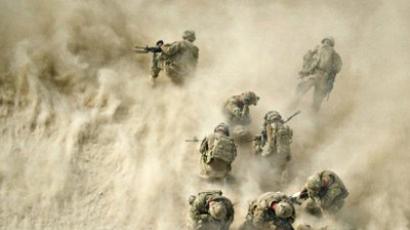'Shocking' US military spending since 9/11

How did America keep the terrorists from winning? Three words: Very. Expensive. Tanks.
A new report reveals that in the decade since the September 11 attacks, the Department of Defense spent around $1 trillion on weaponry for troops in Iraq in Afghanistan.Conservative lawmakers and most of the GOP front-runners meanwhile have insisted that making any cuts to the US Military budget would be detrimental to the defense of the nation. As the country continues to hemorrhage money abroad and a financial crisis is causing a second recession in just as few years, however, the United States have wasted $1 trillion on wars that a recent poll showed that even those who served didn’t think was worth it.In the recently released report from the Stimson Center, "What We Bought: Defense Procurement From FY01 to FY10,” it is revealed that rather than investing the Pentagon’s massive budget in the troops themselves, the United States spent colossal amounts on modernizing its army with tanks, ships, jets and other warcraft. In addition to the allocated budget for the DoD, the Pentagon also dipped deeper into the taxpayers’ pockets by spending over $232 billion in supplemental funds bulking up its line of defense.As RT reported last month, a third of the men and women who served in the Afghanistan and Iraqi wars told pollsters at the Pew Research Center that they while they support America, they did not feel like those two wars were its toll.At the same time that the Stimson Center released their report this week, the chiefs of the US military, including heads of the Army, Navy, Marines and Air Force, all testified before Congress to say that proposed cuts of $1 trillion over the next decade would destroy America’s defense as we know it. Marine Corps Commandant James Amos said in a statement that his troops would not be able to sustain “even on major contingency” if cuts to that degree are carried out.In a joint statement from Russ Rumbauh of the Stimson Center and Todd Harrison of the Center for Strategic and Budgetary Assessments, however, they say that proposed budget cuts would reduce the DoD’s fiscal cash flow for the year 2013 to the same amount the America was working with back in 2007, adjusted for inflation.“A decline in the base budget of this magnitude — returning to the same level of funding as FY 2007 – does not have to be a disaster,” Harrison writes to Business Week.According to his, not only has the military’s procurement funding nearly doubled between the 2001 and 2010 fiscal years, but that the major weapons program that constitutes that hearty of the services’ capabilities was modernized with an astounding purchasing of machinery. And as far as the current state of the country’s economy goes, it doesn’t seem that the military is all that concerned either. The report reveals that, taking into account price changes for inflation, the United States spent 800 percent more on each of the 25 jets it purchased last year when compared to the fleet it bought back in 1980.














